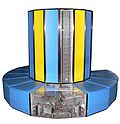Cray X-MP
The Cray X-MP was a supercomputer designed, built and sold by Cray Research. The company's first shared-memory, parallel vector processor (PVP) machine. It was the 1982 "cleaned up" successor to the 1976 Cray-1, and the world's fastest computer 1983–1985. The principal designer was Steve Chen.
Description

The X-MP shared the "horseshoe" design of the earlier machine and looked almost identical on the outside. The processors initially ran on a 9.5 nanosecond (105 MHz) clock (compared to 12.5 ns for the Cray-1A), delivering a theoretical peak speed of 200 megaflops per processor and 400 megaflops for the original two processor 1982 machine[1]. Other improvements over the Cray-1 included: better chaining support and shared memory access with multiple memory ports per processor.
Cray Research continually enhanced the X-MP over the years. The X-MP/48 (1984) contained 4 CPUs with theoretical system peak speed of over 800 megaflops[1]. The X-MP/48 also introduced vector gather/scatter memory reference instructions to the product line. Clock speeds were improved to 8.5 ns (117 MHz), giving a per-cpu peak speed of over 230 MFlops[citation needed]. Memory sizes were also increased over time, culminating in the X-MP/EA series machines (1986) which offered the newer Cray Y-MP 32-bit memory addressing, in addition to the older Cray-1 compatible 24-bit addressing.
The system initially ran the proprietary Cray Operating System (COS) and was object-code compatible with the Cray-1. UniCOS (a UNIX System V derivative) ran through a guest operating system facility. UniCOS became the main OS from 1986 onwards. The DOE ran the Cray Time Sharing System OS instead. The Cray X-MP was used for rendering "The Adventures of André and Wally B.," a short film by the Lucasfilm Computer Graphics Project, which evolved into Pixar Animation Studios. The Cray X-MP was also used for rendering graphics in The Last Starfighter.
Configurations
The X-MP was sold with one, two, or four processors and from two to sixteen megawords (16–128 MB) of word-addressable RAM main memory[1] (while initial memory capacity was limited to 16 megawords with a 24-bit address register, the later extended memory architecture XMP/EA raised addressable memory to a theoretical 2 gigawords, in practice the largest memory produced was 64 megawords). The XMP/EA had an 8.5 nanosecond clock, delivering a theoretical peak speed of 942 megaflops. In comparison to modern CPU speeds, the X-MP had less than half of the raw power of Microsoft's Xbox console or less than 8% of an Intel Core 2 Duo E6700 (12.53 gigaflops)[citation needed].
The I/O subsystem could have two to four I/O processors with a total of two to 32 disk storage units. The DD-39 and DD-49 hard drives each stored 1.2 GB with 5.9 MB/s and 9.8 MB/s transfer rates, respectively. Optional solid state drives were available with 256, 512 or 1024 MB with transfer rates of 100 to 1000 MB/s per channel[1].
A 1984 X-MP/48 was about US$15 million plus the cost of disks, and in 1985 Bell Labs purchased a Cray X-MP/24 for $10.5 million along with eight DD-49 1.2 GB drives for an additional $1 million, They also received $1.5 million in trade-in credit for their Cray 1.[2]
Image gallery
-
Control panel of the CRAY-XMP48
-
Logic boards of the CRAY-XMP48
-
Cooling system of the CRAY-XMP48
Successors
The Cray-2, a completely new design, was introduced 1985. A very different compact four-processor design with from 64 MW to 512 MW (512 MB to 4 GB) of main memory, it was specified to 500 megaflops but was slower than the X-MP on certain calculations due to its high memory latency. (In 1986 an X-MP/48 achieved a speed of 713 megaflops on the standardized LINPACK tests.)
The X-MP-succeeding Cray Y-MP series was sold from 1988; it also had a new design, replacing the 16 Gate Array design with a more compact VLSI chip design with larger circuit boards. It was a major improvement of the X-MP with up to eight processors.
In popular culture
- The parallel-processor nature of the X-MP and its ability to solve multi-variate simultaneous equations rapidly receives honourable mention in Tom Clancy's novel, The Hunt for Red October, when 'Skip' Tyler uses the USAF's X-MP machine to work out the performance and sonic characteristics of the October for Jack Ryan on behalf of the CIA in return for both profit and the chance to evaluate the vessel should it be successfully gained either temporarily or better yet permanently. The X-MP solves the polyvariate program and its possible permutations in less than 15 minutes, which remains excellent digital performance.
- The X-MP and its successor model, the Y-MP, were responsible for the genesis of the 3D Computer Graphic movie as entertainment, in the period 1975-1987. The film The Last Starfighter depends heavily on (for the time) high polygon count models with complex lighting effects, the rendering of which was made possible by the use of these supercomputers. Techniques and software routines pioneered for this film have since been extended and become staples of 3D computer graphics rendering in professional applications internationally.
- A horseshoe-shaped X-MP-like computer acts as a furniture-prop for Robert Redford and Ben Kingsley in the hacker-thriller film Sneakers.
- In Michael Crichton's novel Jurassic Park, three Cray X-MPs provide the park's computing power; but in the movie they are replaced by a Thinking Machines system. Also, in Jurassic Park: Trespasser, a Cray X-MP is featured as the supercomputer supporting Site B.
References
- ^ a b c d "The Cray X-MP Series of Computer Systems" (PDF) (Press release). Cray. 1985.
- ^ Dennis Ritchie (2000-09). "Two Cray X/MP papers". Retrieved 2009-04-02.
{{cite web}}: Check date values in:|date=(help)




